Rank badges ming dynasty Stock Photos and Images
 Rank Badge with Qilin, Ming dynasty (1368–1644), 16th–early 17th century, China, Silk embroidery on silk gauze, Overall: 13 1/2 Stock Photohttps://www.alamy.com/image-license-details/?v=1https://www.alamy.com/stock-image-rank-badge-with-qilin-ming-dynasty-13681644-16thearly-17th-century-162424222.html
Rank Badge with Qilin, Ming dynasty (1368–1644), 16th–early 17th century, China, Silk embroidery on silk gauze, Overall: 13 1/2 Stock Photohttps://www.alamy.com/image-license-details/?v=1https://www.alamy.com/stock-image-rank-badge-with-qilin-ming-dynasty-13681644-16thearly-17th-century-162424222.htmlRMKC71N2–Rank Badge with Qilin, Ming dynasty (1368–1644), 16th–early 17th century, China, Silk embroidery on silk gauze, Overall: 13 1/2
 Art inspired by Rank Badge with Qilin, Ming dynasty (1368–1644), 16th–early 17th century, China, Silk embroidery on silk gauze, Overall: 13 1/2 x 13 1/2 in. (34.3 x 34.3 cm), Textiles-Embroidered, The unusual animal on this rank badge is an alternative representation of the qilin, an, Classic works modernized by Artotop with a splash of modernity. Shapes, color and value, eye-catching visual impact on art. Emotions through freedom of artworks in a contemporary way. A timeless message pursuing a wildly creative new direction. Artists turning to the digital medium and creating the Artotop NFT Stock Photohttps://www.alamy.com/image-license-details/?v=1https://www.alamy.com/art-inspired-by-rank-badge-with-qilin-ming-dynasty-13681644-16thearly-17th-century-china-silk-embroidery-on-silk-gauze-overall-13-12-x-13-12-in-343-x-343-cm-textiles-embroidered-the-unusual-animal-on-this-rank-badge-is-an-alternative-representation-of-the-qilin-an-classic-works-modernized-by-artotop-with-a-splash-of-modernity-shapes-color-and-value-eye-catching-visual-impact-on-art-emotions-through-freedom-of-artworks-in-a-contemporary-way-a-timeless-message-pursuing-a-wildly-creative-new-direction-artists-turning-to-the-digital-medium-and-creating-the-artotop-nft-image462773880.html
Art inspired by Rank Badge with Qilin, Ming dynasty (1368–1644), 16th–early 17th century, China, Silk embroidery on silk gauze, Overall: 13 1/2 x 13 1/2 in. (34.3 x 34.3 cm), Textiles-Embroidered, The unusual animal on this rank badge is an alternative representation of the qilin, an, Classic works modernized by Artotop with a splash of modernity. Shapes, color and value, eye-catching visual impact on art. Emotions through freedom of artworks in a contemporary way. A timeless message pursuing a wildly creative new direction. Artists turning to the digital medium and creating the Artotop NFT Stock Photohttps://www.alamy.com/image-license-details/?v=1https://www.alamy.com/art-inspired-by-rank-badge-with-qilin-ming-dynasty-13681644-16thearly-17th-century-china-silk-embroidery-on-silk-gauze-overall-13-12-x-13-12-in-343-x-343-cm-textiles-embroidered-the-unusual-animal-on-this-rank-badge-is-an-alternative-representation-of-the-qilin-an-classic-works-modernized-by-artotop-with-a-splash-of-modernity-shapes-color-and-value-eye-catching-visual-impact-on-art-emotions-through-freedom-of-artworks-in-a-contemporary-way-a-timeless-message-pursuing-a-wildly-creative-new-direction-artists-turning-to-the-digital-medium-and-creating-the-artotop-nft-image462773880.htmlRF2HTW4PG–Art inspired by Rank Badge with Qilin, Ming dynasty (1368–1644), 16th–early 17th century, China, Silk embroidery on silk gauze, Overall: 13 1/2 x 13 1/2 in. (34.3 x 34.3 cm), Textiles-Embroidered, The unusual animal on this rank badge is an alternative representation of the qilin, an, Classic works modernized by Artotop with a splash of modernity. Shapes, color and value, eye-catching visual impact on art. Emotions through freedom of artworks in a contemporary way. A timeless message pursuing a wildly creative new direction. Artists turning to the digital medium and creating the Artotop NFT
 Medallion with two peacocks. Culture: China. Dimensions: Overall: 14 x 14 in. (35.6 x 35.6 cm) Mount: 17 1/2 x 18 in. (44.5 x 45.7 cm). Date: 16th century. This medallion was a badge for a civil official of the third rank in the Ming dynasty. Originally square, it has been cut, perhaps to serve as the cover for a round box. Ming-dynasty rank badges were usually woven or embroidered as part of an official's robe; later, in the Qing dynasty, separate badges were applied to their garments. Museum: Metropolitan Museum of Art, New York, USA. Stock Photohttps://www.alamy.com/image-license-details/?v=1https://www.alamy.com/medallion-with-two-peacocks-culture-china-dimensions-overall-14-x-14-in-356-x-356-cm-mount-17-12-x-18-in-445-x-457-cm-date-16th-century-this-medallion-was-a-badge-for-a-civil-official-of-the-third-rank-in-the-ming-dynasty-originally-square-it-has-been-cut-perhaps-to-serve-as-the-cover-for-a-round-box-ming-dynasty-rank-badges-were-usually-woven-or-embroidered-as-part-of-an-officials-robe-later-in-the-qing-dynasty-separate-badges-were-applied-to-their-garments-museum-metropolitan-museum-of-art-new-york-usa-image212916160.html
Medallion with two peacocks. Culture: China. Dimensions: Overall: 14 x 14 in. (35.6 x 35.6 cm) Mount: 17 1/2 x 18 in. (44.5 x 45.7 cm). Date: 16th century. This medallion was a badge for a civil official of the third rank in the Ming dynasty. Originally square, it has been cut, perhaps to serve as the cover for a round box. Ming-dynasty rank badges were usually woven or embroidered as part of an official's robe; later, in the Qing dynasty, separate badges were applied to their garments. Museum: Metropolitan Museum of Art, New York, USA. Stock Photohttps://www.alamy.com/image-license-details/?v=1https://www.alamy.com/medallion-with-two-peacocks-culture-china-dimensions-overall-14-x-14-in-356-x-356-cm-mount-17-12-x-18-in-445-x-457-cm-date-16th-century-this-medallion-was-a-badge-for-a-civil-official-of-the-third-rank-in-the-ming-dynasty-originally-square-it-has-been-cut-perhaps-to-serve-as-the-cover-for-a-round-box-ming-dynasty-rank-badges-were-usually-woven-or-embroidered-as-part-of-an-officials-robe-later-in-the-qing-dynasty-separate-badges-were-applied-to-their-garments-museum-metropolitan-museum-of-art-new-york-usa-image212916160.htmlRMPAB4MG–Medallion with two peacocks. Culture: China. Dimensions: Overall: 14 x 14 in. (35.6 x 35.6 cm) Mount: 17 1/2 x 18 in. (44.5 x 45.7 cm). Date: 16th century. This medallion was a badge for a civil official of the third rank in the Ming dynasty. Originally square, it has been cut, perhaps to serve as the cover for a round box. Ming-dynasty rank badges were usually woven or embroidered as part of an official's robe; later, in the Qing dynasty, separate badges were applied to their garments. Museum: Metropolitan Museum of Art, New York, USA.
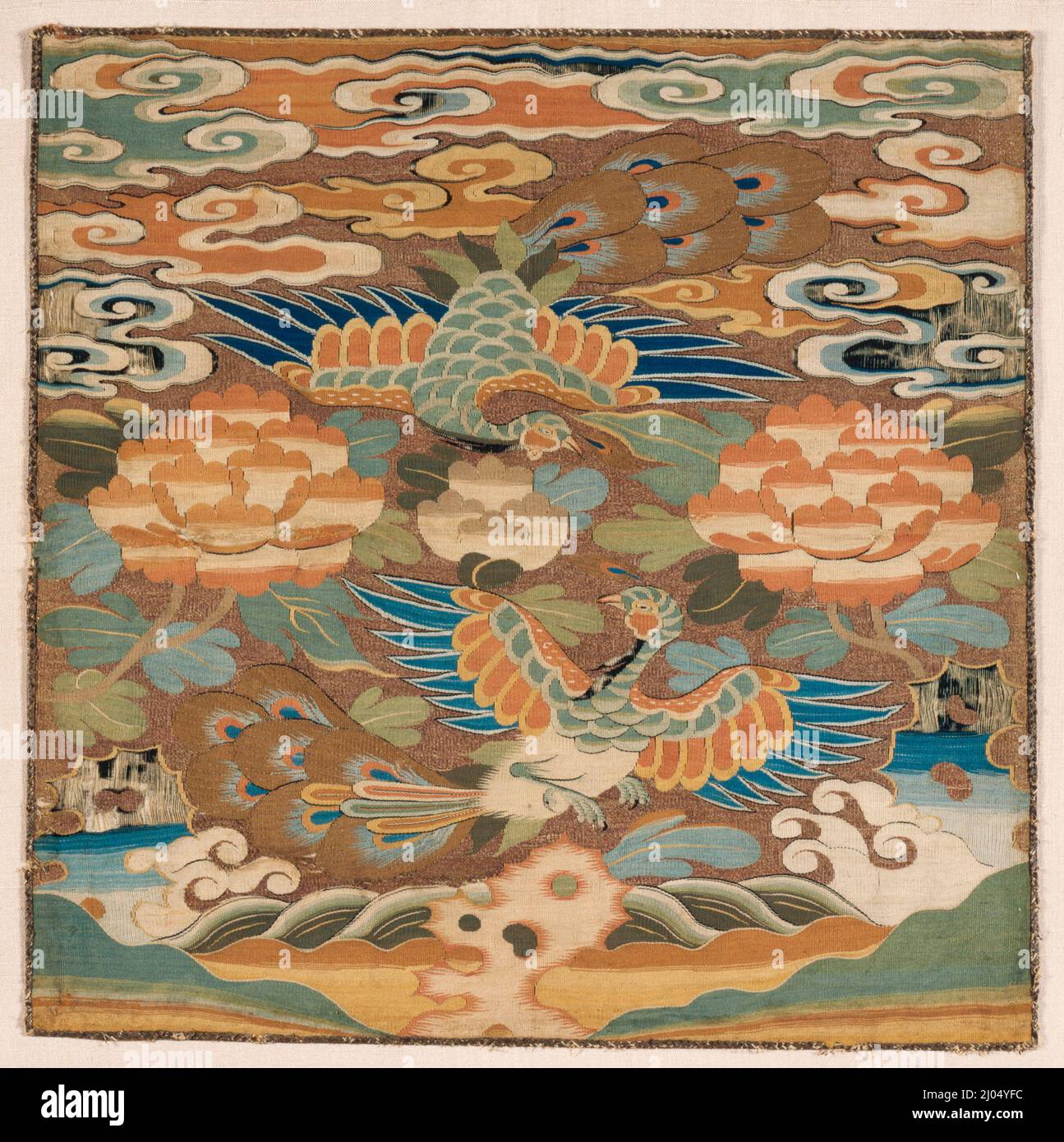 Court Rank Badge (Buzi). China, Ming dynasty (1368-1644), 16th century. Jewelry and Adornments; badges. Silk and metallic-wrapped thread tapestry weave (kesi) Stock Photohttps://www.alamy.com/image-license-details/?v=1https://www.alamy.com/court-rank-badge-buzi-china-ming-dynasty-1368-1644-16th-century-jewelry-and-adornments-badges-silk-and-metallic-wrapped-thread-tapestry-weave-kesi-image464789344.html
Court Rank Badge (Buzi). China, Ming dynasty (1368-1644), 16th century. Jewelry and Adornments; badges. Silk and metallic-wrapped thread tapestry weave (kesi) Stock Photohttps://www.alamy.com/image-license-details/?v=1https://www.alamy.com/court-rank-badge-buzi-china-ming-dynasty-1368-1644-16th-century-jewelry-and-adornments-badges-silk-and-metallic-wrapped-thread-tapestry-weave-kesi-image464789344.htmlRM2J04YFC–Court Rank Badge (Buzi). China, Ming dynasty (1368-1644), 16th century. Jewelry and Adornments; badges. Silk and metallic-wrapped thread tapestry weave (kesi)
 Rank Badge China The bird shown on this badge is a crane, corresponding to the highest rank of civil official. The badge is woven in a fine silk tapestry weave (kesi) with some details, especially outlines, in metallic thread. The sun, at the upper right, was a Qing-dynasty innovation not found on Ming badges.. Rank Badge. China. Silk and metallic thread tapestry (kesi). Qing dynasty (1644–1911), Kangxi period (1662–1722). Textiles-Tapestries Stock Photohttps://www.alamy.com/image-license-details/?v=1https://www.alamy.com/rank-badge-china-the-bird-shown-on-this-badge-is-a-crane-corresponding-to-the-highest-rank-of-civil-official-the-badge-is-woven-in-a-fine-silk-tapestry-weave-kesi-with-some-details-especially-outlines-in-metallic-thread-the-sun-at-the-upper-right-was-a-qing-dynasty-innovation-not-found-on-ming-badges-rank-badge-china-silk-and-metallic-thread-tapestry-kesi-qing-dynasty-16441911-kangxi-period-16621722-textiles-tapestries-image457904709.html
Rank Badge China The bird shown on this badge is a crane, corresponding to the highest rank of civil official. The badge is woven in a fine silk tapestry weave (kesi) with some details, especially outlines, in metallic thread. The sun, at the upper right, was a Qing-dynasty innovation not found on Ming badges.. Rank Badge. China. Silk and metallic thread tapestry (kesi). Qing dynasty (1644–1911), Kangxi period (1662–1722). Textiles-Tapestries Stock Photohttps://www.alamy.com/image-license-details/?v=1https://www.alamy.com/rank-badge-china-the-bird-shown-on-this-badge-is-a-crane-corresponding-to-the-highest-rank-of-civil-official-the-badge-is-woven-in-a-fine-silk-tapestry-weave-kesi-with-some-details-especially-outlines-in-metallic-thread-the-sun-at-the-upper-right-was-a-qing-dynasty-innovation-not-found-on-ming-badges-rank-badge-china-silk-and-metallic-thread-tapestry-kesi-qing-dynasty-16441911-kangxi-period-16621722-textiles-tapestries-image457904709.htmlRM2HGYA3H–Rank Badge China The bird shown on this badge is a crane, corresponding to the highest rank of civil official. The badge is woven in a fine silk tapestry weave (kesi) with some details, especially outlines, in metallic thread. The sun, at the upper right, was a Qing-dynasty innovation not found on Ming badges.. Rank Badge. China. Silk and metallic thread tapestry (kesi). Qing dynasty (1644–1911), Kangxi period (1662–1722). Textiles-Tapestries
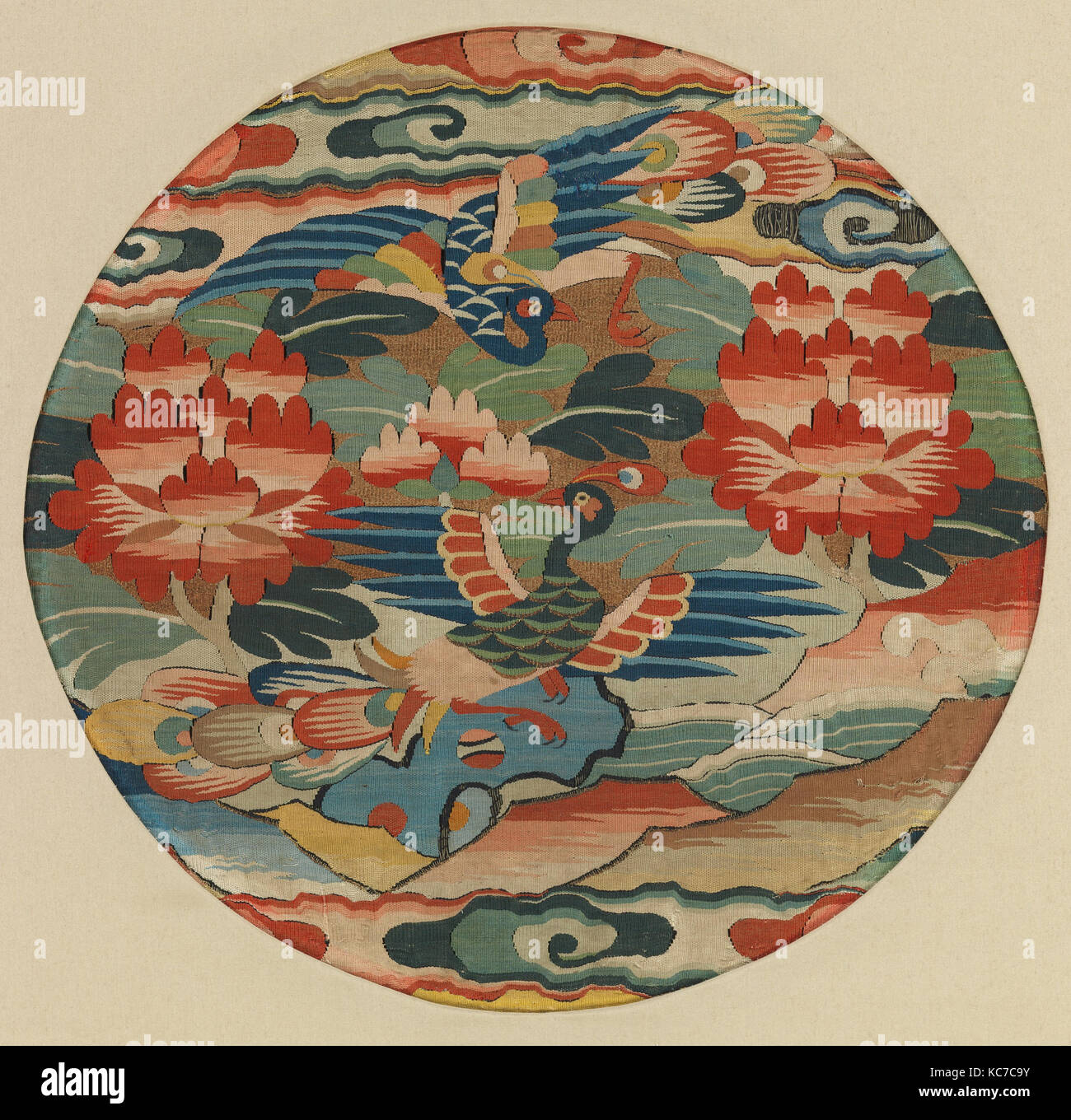 Medallion with Two Peacocks, Ming dynasty (1368–1644), 16th century, China, Silk and metallic-thread tapestry (kesi), Overall: 1 Stock Photohttps://www.alamy.com/image-license-details/?v=1https://www.alamy.com/stock-image-medallion-with-two-peacocks-ming-dynasty-13681644-16th-century-china-162432535.html
Medallion with Two Peacocks, Ming dynasty (1368–1644), 16th century, China, Silk and metallic-thread tapestry (kesi), Overall: 1 Stock Photohttps://www.alamy.com/image-license-details/?v=1https://www.alamy.com/stock-image-medallion-with-two-peacocks-ming-dynasty-13681644-16th-century-china-162432535.htmlRMKC7C9Y–Medallion with Two Peacocks, Ming dynasty (1368–1644), 16th century, China, Silk and metallic-thread tapestry (kesi), Overall: 1
 Art inspired by Medallion with Two Peacocks, Ming dynasty (1368–1644), 16th century, China, Silk and metallic-thread tapestry (kesi), Overall: 14 x 14 in. (35.6 x 35.6 cm), Textiles-Tapestries, This medallion was a rank badge for a civil official of the third rank during the Ming, Classic works modernized by Artotop with a splash of modernity. Shapes, color and value, eye-catching visual impact on art. Emotions through freedom of artworks in a contemporary way. A timeless message pursuing a wildly creative new direction. Artists turning to the digital medium and creating the Artotop NFT Stock Photohttps://www.alamy.com/image-license-details/?v=1https://www.alamy.com/art-inspired-by-medallion-with-two-peacocks-ming-dynasty-13681644-16th-century-china-silk-and-metallic-thread-tapestry-kesi-overall-14-x-14-in-356-x-356-cm-textiles-tapestries-this-medallion-was-a-rank-badge-for-a-civil-official-of-the-third-rank-during-the-ming-classic-works-modernized-by-artotop-with-a-splash-of-modernity-shapes-color-and-value-eye-catching-visual-impact-on-art-emotions-through-freedom-of-artworks-in-a-contemporary-way-a-timeless-message-pursuing-a-wildly-creative-new-direction-artists-turning-to-the-digital-medium-and-creating-the-artotop-nft-image462760825.html
Art inspired by Medallion with Two Peacocks, Ming dynasty (1368–1644), 16th century, China, Silk and metallic-thread tapestry (kesi), Overall: 14 x 14 in. (35.6 x 35.6 cm), Textiles-Tapestries, This medallion was a rank badge for a civil official of the third rank during the Ming, Classic works modernized by Artotop with a splash of modernity. Shapes, color and value, eye-catching visual impact on art. Emotions through freedom of artworks in a contemporary way. A timeless message pursuing a wildly creative new direction. Artists turning to the digital medium and creating the Artotop NFT Stock Photohttps://www.alamy.com/image-license-details/?v=1https://www.alamy.com/art-inspired-by-medallion-with-two-peacocks-ming-dynasty-13681644-16th-century-china-silk-and-metallic-thread-tapestry-kesi-overall-14-x-14-in-356-x-356-cm-textiles-tapestries-this-medallion-was-a-rank-badge-for-a-civil-official-of-the-third-rank-during-the-ming-classic-works-modernized-by-artotop-with-a-splash-of-modernity-shapes-color-and-value-eye-catching-visual-impact-on-art-emotions-through-freedom-of-artworks-in-a-contemporary-way-a-timeless-message-pursuing-a-wildly-creative-new-direction-artists-turning-to-the-digital-medium-and-creating-the-artotop-nft-image462760825.htmlRF2HTTG49–Art inspired by Medallion with Two Peacocks, Ming dynasty (1368–1644), 16th century, China, Silk and metallic-thread tapestry (kesi), Overall: 14 x 14 in. (35.6 x 35.6 cm), Textiles-Tapestries, This medallion was a rank badge for a civil official of the third rank during the Ming, Classic works modernized by Artotop with a splash of modernity. Shapes, color and value, eye-catching visual impact on art. Emotions through freedom of artworks in a contemporary way. A timeless message pursuing a wildly creative new direction. Artists turning to the digital medium and creating the Artotop NFT
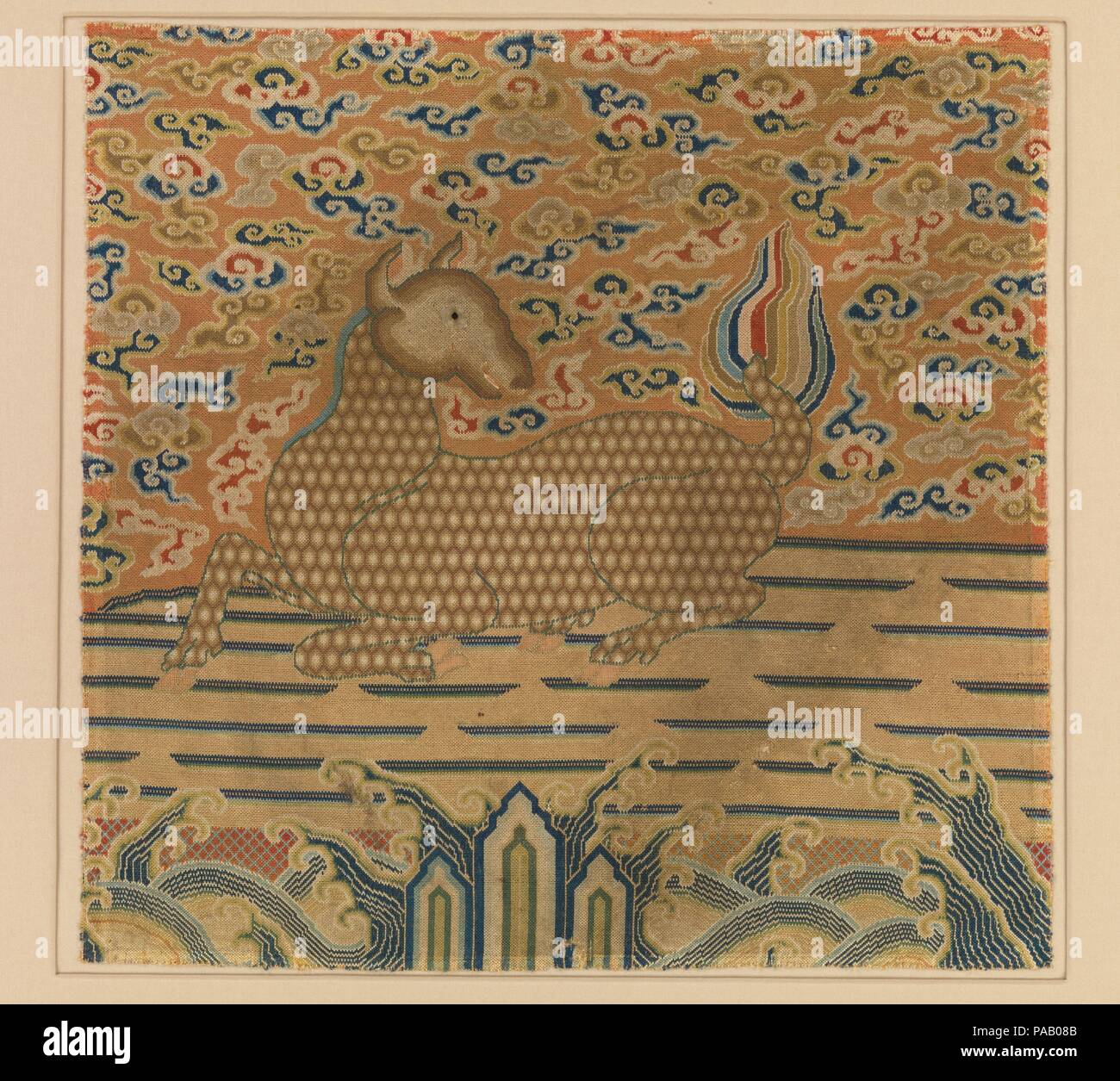 Rank Badge with Qilin. Culture: China. Dimensions: Overall: 13 1/2 x 13 1/2 in. (34.3 x 34.3 cm). Date: 16th-early 17th century. The unusual animal on this rank badge is an alternative representation of the qilin, an auspicious mythological beast that is said to appear in the reign of a virtuous ruler. In the Ming dynasty, qilin badges were worn as the insignia of nobles. The qilin seen here is similar to one on a badge excavated from the tomb of Duke Xu Fu, who died in 1517. The animal in Xu Fu's badge has a slightly longer neck, but its coat has a similar hexagonal pattern. That pattern is Stock Photohttps://www.alamy.com/image-license-details/?v=1https://www.alamy.com/rank-badge-with-qilin-culture-china-dimensions-overall-13-12-x-13-12-in-343-x-343-cm-date-16th-early-17th-century-the-unusual-animal-on-this-rank-badge-is-an-alternative-representation-of-the-qilin-an-auspicious-mythological-beast-that-is-said-to-appear-in-the-reign-of-a-virtuous-ruler-in-the-ming-dynasty-qilin-badges-were-worn-as-the-insignia-of-nobles-the-qilin-seen-here-is-similar-to-one-on-a-badge-excavated-from-the-tomb-of-duke-xu-fu-who-died-in-1517-the-animal-in-xu-fus-badge-has-a-slightly-longer-neck-but-its-coat-has-a-similar-hexagonal-pattern-that-pattern-is-image212912683.html
Rank Badge with Qilin. Culture: China. Dimensions: Overall: 13 1/2 x 13 1/2 in. (34.3 x 34.3 cm). Date: 16th-early 17th century. The unusual animal on this rank badge is an alternative representation of the qilin, an auspicious mythological beast that is said to appear in the reign of a virtuous ruler. In the Ming dynasty, qilin badges were worn as the insignia of nobles. The qilin seen here is similar to one on a badge excavated from the tomb of Duke Xu Fu, who died in 1517. The animal in Xu Fu's badge has a slightly longer neck, but its coat has a similar hexagonal pattern. That pattern is Stock Photohttps://www.alamy.com/image-license-details/?v=1https://www.alamy.com/rank-badge-with-qilin-culture-china-dimensions-overall-13-12-x-13-12-in-343-x-343-cm-date-16th-early-17th-century-the-unusual-animal-on-this-rank-badge-is-an-alternative-representation-of-the-qilin-an-auspicious-mythological-beast-that-is-said-to-appear-in-the-reign-of-a-virtuous-ruler-in-the-ming-dynasty-qilin-badges-were-worn-as-the-insignia-of-nobles-the-qilin-seen-here-is-similar-to-one-on-a-badge-excavated-from-the-tomb-of-duke-xu-fu-who-died-in-1517-the-animal-in-xu-fus-badge-has-a-slightly-longer-neck-but-its-coat-has-a-similar-hexagonal-pattern-that-pattern-is-image212912683.htmlRMPAB08B–Rank Badge with Qilin. Culture: China. Dimensions: Overall: 13 1/2 x 13 1/2 in. (34.3 x 34.3 cm). Date: 16th-early 17th century. The unusual animal on this rank badge is an alternative representation of the qilin, an auspicious mythological beast that is said to appear in the reign of a virtuous ruler. In the Ming dynasty, qilin badges were worn as the insignia of nobles. The qilin seen here is similar to one on a badge excavated from the tomb of Duke Xu Fu, who died in 1517. The animal in Xu Fu's badge has a slightly longer neck, but its coat has a similar hexagonal pattern. That pattern is
 Medallion with two peacocks 16th century China This medallion was a badge for a civil official of the third rank in the Ming dynasty. Originally square, it has been cut, perhaps to serve as the cover for a round box. Ming-dynasty rank badges were usually woven or embroidered as part of an official’s robe; later, in the Qing dynasty, separate badges were applied to their garments.. Medallion with two peacocks. China. 16th century. Silk and metallic thread tapestry (kesi). Ming dynasty (1368–1644). Textiles-Tapestries Stock Photohttps://www.alamy.com/image-license-details/?v=1https://www.alamy.com/medallion-with-two-peacocks-16th-century-china-this-medallion-was-a-badge-for-a-civil-official-of-the-third-rank-in-the-ming-dynasty-originally-square-it-has-been-cut-perhaps-to-serve-as-the-cover-for-a-round-box-ming-dynasty-rank-badges-were-usually-woven-or-embroidered-as-part-of-an-officials-robe-later-in-the-qing-dynasty-separate-badges-were-applied-to-their-garments-medallion-with-two-peacocks-china-16th-century-silk-and-metallic-thread-tapestry-kesi-ming-dynasty-13681644-textiles-tapestries-image457892654.html
Medallion with two peacocks 16th century China This medallion was a badge for a civil official of the third rank in the Ming dynasty. Originally square, it has been cut, perhaps to serve as the cover for a round box. Ming-dynasty rank badges were usually woven or embroidered as part of an official’s robe; later, in the Qing dynasty, separate badges were applied to their garments.. Medallion with two peacocks. China. 16th century. Silk and metallic thread tapestry (kesi). Ming dynasty (1368–1644). Textiles-Tapestries Stock Photohttps://www.alamy.com/image-license-details/?v=1https://www.alamy.com/medallion-with-two-peacocks-16th-century-china-this-medallion-was-a-badge-for-a-civil-official-of-the-third-rank-in-the-ming-dynasty-originally-square-it-has-been-cut-perhaps-to-serve-as-the-cover-for-a-round-box-ming-dynasty-rank-badges-were-usually-woven-or-embroidered-as-part-of-an-officials-robe-later-in-the-qing-dynasty-separate-badges-were-applied-to-their-garments-medallion-with-two-peacocks-china-16th-century-silk-and-metallic-thread-tapestry-kesi-ming-dynasty-13681644-textiles-tapestries-image457892654.htmlRM2HGXPN2–Medallion with two peacocks 16th century China This medallion was a badge for a civil official of the third rank in the Ming dynasty. Originally square, it has been cut, perhaps to serve as the cover for a round box. Ming-dynasty rank badges were usually woven or embroidered as part of an official’s robe; later, in the Qing dynasty, separate badges were applied to their garments.. Medallion with two peacocks. China. 16th century. Silk and metallic thread tapestry (kesi). Ming dynasty (1368–1644). Textiles-Tapestries
 Rank Badge with a Pair of Cranes late 19th century Korea In 1454, the court of the Joseon dynasty (1392–1910) adopted a system of insignia of rank for civil and military officials based on that of China's Ming dynasty (1368–1644). Square badges of embroidered birds and animals on silk were worn on the front (hyung) and back (bae) of official costumes. They are clearly differentiated from the round badges embroidered with a dragon (called bo) worn by the king and the crown prince on the front, back, and shoulders of their court attire. Besides being ornamental, rank badges served as visible sta Stock Photohttps://www.alamy.com/image-license-details/?v=1https://www.alamy.com/rank-badge-with-a-pair-of-cranes-late-19th-century-korea-in-1454-the-court-of-the-joseon-dynasty-13921910-adopted-a-system-of-insignia-of-rank-for-civil-and-military-officials-based-on-that-of-chinas-ming-dynasty-13681644-square-badges-of-embroidered-birds-and-animals-on-silk-were-worn-on-the-front-hyung-and-back-bae-of-official-costumes-they-are-clearly-differentiated-from-the-round-badges-embroidered-with-a-dragon-called-bo-worn-by-the-king-and-the-crown-prince-on-the-front-back-and-shoulders-of-their-court-attire-besides-being-ornamental-rank-badges-served-as-visible-sta-image458155468.html
Rank Badge with a Pair of Cranes late 19th century Korea In 1454, the court of the Joseon dynasty (1392–1910) adopted a system of insignia of rank for civil and military officials based on that of China's Ming dynasty (1368–1644). Square badges of embroidered birds and animals on silk were worn on the front (hyung) and back (bae) of official costumes. They are clearly differentiated from the round badges embroidered with a dragon (called bo) worn by the king and the crown prince on the front, back, and shoulders of their court attire. Besides being ornamental, rank badges served as visible sta Stock Photohttps://www.alamy.com/image-license-details/?v=1https://www.alamy.com/rank-badge-with-a-pair-of-cranes-late-19th-century-korea-in-1454-the-court-of-the-joseon-dynasty-13921910-adopted-a-system-of-insignia-of-rank-for-civil-and-military-officials-based-on-that-of-chinas-ming-dynasty-13681644-square-badges-of-embroidered-birds-and-animals-on-silk-were-worn-on-the-front-hyung-and-back-bae-of-official-costumes-they-are-clearly-differentiated-from-the-round-badges-embroidered-with-a-dragon-called-bo-worn-by-the-king-and-the-crown-prince-on-the-front-back-and-shoulders-of-their-court-attire-besides-being-ornamental-rank-badges-served-as-visible-sta-image458155468.htmlRM2HHANY8–Rank Badge with a Pair of Cranes late 19th century Korea In 1454, the court of the Joseon dynasty (1392–1910) adopted a system of insignia of rank for civil and military officials based on that of China's Ming dynasty (1368–1644). Square badges of embroidered birds and animals on silk were worn on the front (hyung) and back (bae) of official costumes. They are clearly differentiated from the round badges embroidered with a dragon (called bo) worn by the king and the crown prince on the front, back, and shoulders of their court attire. Besides being ornamental, rank badges served as visible sta
 Rank Badge with a Pair of Cranes, late 19th century Stock Photohttps://www.alamy.com/image-license-details/?v=1https://www.alamy.com/stock-image-rank-badge-with-a-pair-of-cranes-late-19th-century-162402478.html
Rank Badge with a Pair of Cranes, late 19th century Stock Photohttps://www.alamy.com/image-license-details/?v=1https://www.alamy.com/stock-image-rank-badge-with-a-pair-of-cranes-late-19th-century-162402478.htmlRMKC620E–Rank Badge with a Pair of Cranes, late 19th century
 Art inspired by Rank Badge with a Pair of Cranes, Joseon dynasty (1392–1910), late 19th century, Korea, Silk embroidery on silk satin damask, Overall: 8 1/4 x 7 1/2 in. (21 x 19.1 cm), Textiles-Embroidered, In 1454, the court of the Joseon dynasty (1392–1910) adopted a system of, Classic works modernized by Artotop with a splash of modernity. Shapes, color and value, eye-catching visual impact on art. Emotions through freedom of artworks in a contemporary way. A timeless message pursuing a wildly creative new direction. Artists turning to the digital medium and creating the Artotop NFT Stock Photohttps://www.alamy.com/image-license-details/?v=1https://www.alamy.com/art-inspired-by-rank-badge-with-a-pair-of-cranes-joseon-dynasty-13921910-late-19th-century-korea-silk-embroidery-on-silk-satin-damask-overall-8-14-x-7-12-in-21-x-191-cm-textiles-embroidered-in-1454-the-court-of-the-joseon-dynasty-13921910-adopted-a-system-of-classic-works-modernized-by-artotop-with-a-splash-of-modernity-shapes-color-and-value-eye-catching-visual-impact-on-art-emotions-through-freedom-of-artworks-in-a-contemporary-way-a-timeless-message-pursuing-a-wildly-creative-new-direction-artists-turning-to-the-digital-medium-and-creating-the-artotop-nft-image462911439.html
Art inspired by Rank Badge with a Pair of Cranes, Joseon dynasty (1392–1910), late 19th century, Korea, Silk embroidery on silk satin damask, Overall: 8 1/4 x 7 1/2 in. (21 x 19.1 cm), Textiles-Embroidered, In 1454, the court of the Joseon dynasty (1392–1910) adopted a system of, Classic works modernized by Artotop with a splash of modernity. Shapes, color and value, eye-catching visual impact on art. Emotions through freedom of artworks in a contemporary way. A timeless message pursuing a wildly creative new direction. Artists turning to the digital medium and creating the Artotop NFT Stock Photohttps://www.alamy.com/image-license-details/?v=1https://www.alamy.com/art-inspired-by-rank-badge-with-a-pair-of-cranes-joseon-dynasty-13921910-late-19th-century-korea-silk-embroidery-on-silk-satin-damask-overall-8-14-x-7-12-in-21-x-191-cm-textiles-embroidered-in-1454-the-court-of-the-joseon-dynasty-13921910-adopted-a-system-of-classic-works-modernized-by-artotop-with-a-splash-of-modernity-shapes-color-and-value-eye-catching-visual-impact-on-art-emotions-through-freedom-of-artworks-in-a-contemporary-way-a-timeless-message-pursuing-a-wildly-creative-new-direction-artists-turning-to-the-digital-medium-and-creating-the-artotop-nft-image462911439.htmlRF2HW3C7B–Art inspired by Rank Badge with a Pair of Cranes, Joseon dynasty (1392–1910), late 19th century, Korea, Silk embroidery on silk satin damask, Overall: 8 1/4 x 7 1/2 in. (21 x 19.1 cm), Textiles-Embroidered, In 1454, the court of the Joseon dynasty (1392–1910) adopted a system of, Classic works modernized by Artotop with a splash of modernity. Shapes, color and value, eye-catching visual impact on art. Emotions through freedom of artworks in a contemporary way. A timeless message pursuing a wildly creative new direction. Artists turning to the digital medium and creating the Artotop NFT
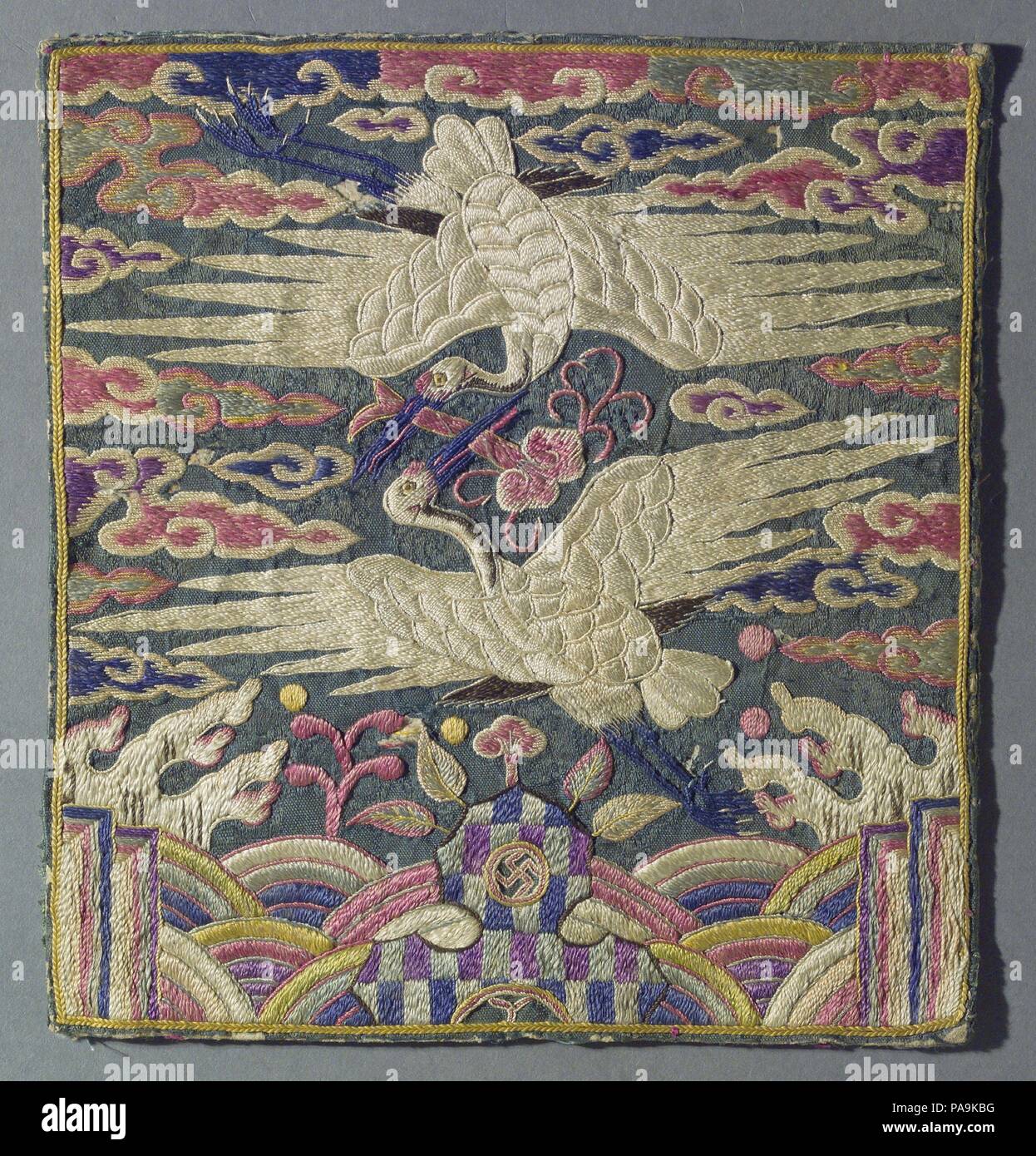 Rank Badge with a Pair of Cranes. Culture: Korea. Dimensions: Overall: 8 1/4 x 7 1/2 in. (21 x 19.1 cm). Date: late 19th century. In 1454, the court of the Joseon dynasty (1392-1910) adopted a system of insignia of rank for civil and military officials based on that of China's Ming dynasty (1368-1644). Square badges of embroidered birds and animals on silk were worn on the front (hyung) and back (bae) of official costumes. They are clearly differentiated from the round badges embroidered with a dragon (called bo) worn by the king and the crown prince on the front, back, and shoulders of their Stock Photohttps://www.alamy.com/image-license-details/?v=1https://www.alamy.com/rank-badge-with-a-pair-of-cranes-culture-korea-dimensions-overall-8-14-x-7-12-in-21-x-191-cm-date-late-19th-century-in-1454-the-court-of-the-joseon-dynasty-1392-1910-adopted-a-system-of-insignia-of-rank-for-civil-and-military-officials-based-on-that-of-chinas-ming-dynasty-1368-1644-square-badges-of-embroidered-birds-and-animals-on-silk-were-worn-on-the-front-hyung-and-back-bae-of-official-costumes-they-are-clearly-differentiated-from-the-round-badges-embroidered-with-a-dragon-called-bo-worn-by-the-king-and-the-crown-prince-on-the-front-back-and-shoulders-of-their-image212883764.html
Rank Badge with a Pair of Cranes. Culture: Korea. Dimensions: Overall: 8 1/4 x 7 1/2 in. (21 x 19.1 cm). Date: late 19th century. In 1454, the court of the Joseon dynasty (1392-1910) adopted a system of insignia of rank for civil and military officials based on that of China's Ming dynasty (1368-1644). Square badges of embroidered birds and animals on silk were worn on the front (hyung) and back (bae) of official costumes. They are clearly differentiated from the round badges embroidered with a dragon (called bo) worn by the king and the crown prince on the front, back, and shoulders of their Stock Photohttps://www.alamy.com/image-license-details/?v=1https://www.alamy.com/rank-badge-with-a-pair-of-cranes-culture-korea-dimensions-overall-8-14-x-7-12-in-21-x-191-cm-date-late-19th-century-in-1454-the-court-of-the-joseon-dynasty-1392-1910-adopted-a-system-of-insignia-of-rank-for-civil-and-military-officials-based-on-that-of-chinas-ming-dynasty-1368-1644-square-badges-of-embroidered-birds-and-animals-on-silk-were-worn-on-the-front-hyung-and-back-bae-of-official-costumes-they-are-clearly-differentiated-from-the-round-badges-embroidered-with-a-dragon-called-bo-worn-by-the-king-and-the-crown-prince-on-the-front-back-and-shoulders-of-their-image212883764.htmlRMPA9KBG–Rank Badge with a Pair of Cranes. Culture: Korea. Dimensions: Overall: 8 1/4 x 7 1/2 in. (21 x 19.1 cm). Date: late 19th century. In 1454, the court of the Joseon dynasty (1392-1910) adopted a system of insignia of rank for civil and military officials based on that of China's Ming dynasty (1368-1644). Square badges of embroidered birds and animals on silk were worn on the front (hyung) and back (bae) of official costumes. They are clearly differentiated from the round badges embroidered with a dragon (called bo) worn by the king and the crown prince on the front, back, and shoulders of their
 Rank Badge with Qilin 16th–early 17th century China The unusual animal on this rank badge is an alternative representation of the qilin, an auspicious mythological beast that is said to appear in the reign of a virtuous ruler. In the Ming dynasty, qilin badges were worn as the insignia of nobles.The qilin seen here is similar to one on a badge excavated from the tomb of Duke Xu Fu, who died in 1517. The animal in Xu Fu's badge has a slightly longer neck, but its coat has a similar hexagonal pattern. That pattern is also found on a painted giraffe exhibited nearby. A gift of this exotic beast t Stock Photohttps://www.alamy.com/image-license-details/?v=1https://www.alamy.com/rank-badge-with-qilin-16thearly-17th-century-china-the-unusual-animal-on-this-rank-badge-is-an-alternative-representation-of-the-qilin-an-auspicious-mythological-beast-that-is-said-to-appear-in-the-reign-of-a-virtuous-ruler-in-the-ming-dynasty-qilin-badges-were-worn-as-the-insignia-of-noblesthe-qilin-seen-here-is-similar-to-one-on-a-badge-excavated-from-the-tomb-of-duke-xu-fu-who-died-in-1517-the-animal-in-xu-fus-badge-has-a-slightly-longer-neck-but-its-coat-has-a-similar-hexagonal-pattern-that-pattern-is-also-found-on-a-painted-giraffe-exhibited-nearby-a-gift-of-this-exotic-beast-t-image458149857.html
Rank Badge with Qilin 16th–early 17th century China The unusual animal on this rank badge is an alternative representation of the qilin, an auspicious mythological beast that is said to appear in the reign of a virtuous ruler. In the Ming dynasty, qilin badges were worn as the insignia of nobles.The qilin seen here is similar to one on a badge excavated from the tomb of Duke Xu Fu, who died in 1517. The animal in Xu Fu's badge has a slightly longer neck, but its coat has a similar hexagonal pattern. That pattern is also found on a painted giraffe exhibited nearby. A gift of this exotic beast t Stock Photohttps://www.alamy.com/image-license-details/?v=1https://www.alamy.com/rank-badge-with-qilin-16thearly-17th-century-china-the-unusual-animal-on-this-rank-badge-is-an-alternative-representation-of-the-qilin-an-auspicious-mythological-beast-that-is-said-to-appear-in-the-reign-of-a-virtuous-ruler-in-the-ming-dynasty-qilin-badges-were-worn-as-the-insignia-of-noblesthe-qilin-seen-here-is-similar-to-one-on-a-badge-excavated-from-the-tomb-of-duke-xu-fu-who-died-in-1517-the-animal-in-xu-fus-badge-has-a-slightly-longer-neck-but-its-coat-has-a-similar-hexagonal-pattern-that-pattern-is-also-found-on-a-painted-giraffe-exhibited-nearby-a-gift-of-this-exotic-beast-t-image458149857.htmlRM2HHAEPW–Rank Badge with Qilin 16th–early 17th century China The unusual animal on this rank badge is an alternative representation of the qilin, an auspicious mythological beast that is said to appear in the reign of a virtuous ruler. In the Ming dynasty, qilin badges were worn as the insignia of nobles.The qilin seen here is similar to one on a badge excavated from the tomb of Duke Xu Fu, who died in 1517. The animal in Xu Fu's badge has a slightly longer neck, but its coat has a similar hexagonal pattern. That pattern is also found on a painted giraffe exhibited nearby. A gift of this exotic beast t
 Rank Badge (buzi), 1850-99. China, Qing dynasty (1644-1911). Silk and metal thread; slit tapestry weave (kesi); overall: 29.5 x 31.3 cm (11 5/8 x 12 5/16 in.). Rank badges (also called rank insignia or Mandarin squares) were used in China during the Ming (1368–1644) and Qing (1644–1911) dynasties to demonstrate the wearer’s rank. In 1391 new clothing regulations directed court officials to wear decorative squares indicating their rank—birds for civil officials and animals for military officials. During the Qing dynasty rank badge design was regulated, and certain creatures were associated wit Stock Photohttps://www.alamy.com/image-license-details/?v=1https://www.alamy.com/rank-badge-buzi-1850-99-china-qing-dynasty-1644-1911-silk-and-metal-thread-slit-tapestry-weave-kesi-overall-295-x-313-cm-11-58-x-12-516-in-rank-badges-also-called-rank-insignia-or-mandarin-squares-were-used-in-china-during-the-ming-13681644-and-qing-16441911-dynasties-to-demonstrate-the-wearers-rank-in-1391-new-clothing-regulations-directed-court-officials-to-wear-decorative-squares-indicating-their-rankbirds-for-civil-officials-and-animals-for-military-officials-during-the-qing-dynasty-rank-badge-design-was-regulated-and-certain-creatures-were-associated-wit-image448085592.html
Rank Badge (buzi), 1850-99. China, Qing dynasty (1644-1911). Silk and metal thread; slit tapestry weave (kesi); overall: 29.5 x 31.3 cm (11 5/8 x 12 5/16 in.). Rank badges (also called rank insignia or Mandarin squares) were used in China during the Ming (1368–1644) and Qing (1644–1911) dynasties to demonstrate the wearer’s rank. In 1391 new clothing regulations directed court officials to wear decorative squares indicating their rank—birds for civil officials and animals for military officials. During the Qing dynasty rank badge design was regulated, and certain creatures were associated wit Stock Photohttps://www.alamy.com/image-license-details/?v=1https://www.alamy.com/rank-badge-buzi-1850-99-china-qing-dynasty-1644-1911-silk-and-metal-thread-slit-tapestry-weave-kesi-overall-295-x-313-cm-11-58-x-12-516-in-rank-badges-also-called-rank-insignia-or-mandarin-squares-were-used-in-china-during-the-ming-13681644-and-qing-16441911-dynasties-to-demonstrate-the-wearers-rank-in-1391-new-clothing-regulations-directed-court-officials-to-wear-decorative-squares-indicating-their-rankbirds-for-civil-officials-and-animals-for-military-officials-during-the-qing-dynasty-rank-badge-design-was-regulated-and-certain-creatures-were-associated-wit-image448085592.htmlRM2H101MT–Rank Badge (buzi), 1850-99. China, Qing dynasty (1644-1911). Silk and metal thread; slit tapestry weave (kesi); overall: 29.5 x 31.3 cm (11 5/8 x 12 5/16 in.). Rank badges (also called rank insignia or Mandarin squares) were used in China during the Ming (1368–1644) and Qing (1644–1911) dynasties to demonstrate the wearer’s rank. In 1391 new clothing regulations directed court officials to wear decorative squares indicating their rank—birds for civil officials and animals for military officials. During the Qing dynasty rank badge design was regulated, and certain creatures were associated wit
 Rank Badge (buzi), 1736-95. China, Qing dynasty (1644-1911), Qianlong reign (1736-1795). Silk, satin weave; silk, gold metal thread, and peacock feather embroidery; overall: 31.1 x 31.1 cm (12 1/4 x 12 1/4 in.). Rank badges (also called rank insignia or Mandarin squares) were used in China during the Ming (1368–1644) and Qing (1644–1911) dynasties to demonstrate the wearer’s rank. In 1391 new clothing regulations directed court officials to wear decorative squares indicating their rank—birds for civil officials and animals for military officials. During the Qing dynasty rank badge design was Stock Photohttps://www.alamy.com/image-license-details/?v=1https://www.alamy.com/rank-badge-buzi-1736-95-china-qing-dynasty-1644-1911-qianlong-reign-1736-1795-silk-satin-weave-silk-gold-metal-thread-and-peacock-feather-embroidery-overall-311-x-311-cm-12-14-x-12-14-in-rank-badges-also-called-rank-insignia-or-mandarin-squares-were-used-in-china-during-the-ming-13681644-and-qing-16441911-dynasties-to-demonstrate-the-wearers-rank-in-1391-new-clothing-regulations-directed-court-officials-to-wear-decorative-squares-indicating-their-rankbirds-for-civil-officials-and-animals-for-military-officials-during-the-qing-dynasty-rank-badge-design-was-image448059751.html
Rank Badge (buzi), 1736-95. China, Qing dynasty (1644-1911), Qianlong reign (1736-1795). Silk, satin weave; silk, gold metal thread, and peacock feather embroidery; overall: 31.1 x 31.1 cm (12 1/4 x 12 1/4 in.). Rank badges (also called rank insignia or Mandarin squares) were used in China during the Ming (1368–1644) and Qing (1644–1911) dynasties to demonstrate the wearer’s rank. In 1391 new clothing regulations directed court officials to wear decorative squares indicating their rank—birds for civil officials and animals for military officials. During the Qing dynasty rank badge design was Stock Photohttps://www.alamy.com/image-license-details/?v=1https://www.alamy.com/rank-badge-buzi-1736-95-china-qing-dynasty-1644-1911-qianlong-reign-1736-1795-silk-satin-weave-silk-gold-metal-thread-and-peacock-feather-embroidery-overall-311-x-311-cm-12-14-x-12-14-in-rank-badges-also-called-rank-insignia-or-mandarin-squares-were-used-in-china-during-the-ming-13681644-and-qing-16441911-dynasties-to-demonstrate-the-wearers-rank-in-1391-new-clothing-regulations-directed-court-officials-to-wear-decorative-squares-indicating-their-rankbirds-for-civil-officials-and-animals-for-military-officials-during-the-qing-dynasty-rank-badge-design-was-image448059751.htmlRM2H0XTNY–Rank Badge (buzi), 1736-95. China, Qing dynasty (1644-1911), Qianlong reign (1736-1795). Silk, satin weave; silk, gold metal thread, and peacock feather embroidery; overall: 31.1 x 31.1 cm (12 1/4 x 12 1/4 in.). Rank badges (also called rank insignia or Mandarin squares) were used in China during the Ming (1368–1644) and Qing (1644–1911) dynasties to demonstrate the wearer’s rank. In 1391 new clothing regulations directed court officials to wear decorative squares indicating their rank—birds for civil officials and animals for military officials. During the Qing dynasty rank badge design was
 Rank Badge with Lion. Culture: China. Dimensions: Overall: 14 1/2 x 14 1/4 in. (36.8 x 36.2 cm). Date: 15th century. During the Ming dynasty, the audience robes of government officials bore insignia designating rank. While different birds represented civil ranks, military ranks were represented by a variety of real and mythical quadrupeds. The lion, as seen on this badge, symbolizes the highest military rank. Museum: Metropolitan Museum of Art, New York, USA. Stock Photohttps://www.alamy.com/image-license-details/?v=1https://www.alamy.com/rank-badge-with-lion-culture-china-dimensions-overall-14-12-x-14-14-in-368-x-362-cm-date-15th-century-during-the-ming-dynasty-the-audience-robes-of-government-officials-bore-insignia-designating-rank-while-different-birds-represented-civil-ranks-military-ranks-were-represented-by-a-variety-of-real-and-mythical-quadrupeds-the-lion-as-seen-on-this-badge-symbolizes-the-highest-military-rank-museum-metropolitan-museum-of-art-new-york-usa-image212914457.html
Rank Badge with Lion. Culture: China. Dimensions: Overall: 14 1/2 x 14 1/4 in. (36.8 x 36.2 cm). Date: 15th century. During the Ming dynasty, the audience robes of government officials bore insignia designating rank. While different birds represented civil ranks, military ranks were represented by a variety of real and mythical quadrupeds. The lion, as seen on this badge, symbolizes the highest military rank. Museum: Metropolitan Museum of Art, New York, USA. Stock Photohttps://www.alamy.com/image-license-details/?v=1https://www.alamy.com/rank-badge-with-lion-culture-china-dimensions-overall-14-12-x-14-14-in-368-x-362-cm-date-15th-century-during-the-ming-dynasty-the-audience-robes-of-government-officials-bore-insignia-designating-rank-while-different-birds-represented-civil-ranks-military-ranks-were-represented-by-a-variety-of-real-and-mythical-quadrupeds-the-lion-as-seen-on-this-badge-symbolizes-the-highest-military-rank-museum-metropolitan-museum-of-art-new-york-usa-image212914457.htmlRMPAB2FN–Rank Badge with Lion. Culture: China. Dimensions: Overall: 14 1/2 x 14 1/4 in. (36.8 x 36.2 cm). Date: 15th century. During the Ming dynasty, the audience robes of government officials bore insignia designating rank. While different birds represented civil ranks, military ranks were represented by a variety of real and mythical quadrupeds. The lion, as seen on this badge, symbolizes the highest military rank. Museum: Metropolitan Museum of Art, New York, USA.
 Rank Badge with Mythological Animal. Culture: China. Dimensions: 13 3/4 x 14 1/2 in. (34.9 x 36.8 cm). Date: late 16th-early 17th century. Museum: Metropolitan Museum of Art, New York, USA. Stock Photohttps://www.alamy.com/image-license-details/?v=1https://www.alamy.com/rank-badge-with-mythological-animal-culture-china-dimensions-13-34-x-14-12-in-349-x-368-cm-date-late-16th-early-17th-century-museum-metropolitan-museum-of-art-new-york-usa-image212904024.html
Rank Badge with Mythological Animal. Culture: China. Dimensions: 13 3/4 x 14 1/2 in. (34.9 x 36.8 cm). Date: late 16th-early 17th century. Museum: Metropolitan Museum of Art, New York, USA. Stock Photohttps://www.alamy.com/image-license-details/?v=1https://www.alamy.com/rank-badge-with-mythological-animal-culture-china-dimensions-13-34-x-14-12-in-349-x-368-cm-date-late-16th-early-17th-century-museum-metropolitan-museum-of-art-new-york-usa-image212904024.htmlRMPAAH74–Rank Badge with Mythological Animal. Culture: China. Dimensions: 13 3/4 x 14 1/2 in. (34.9 x 36.8 cm). Date: late 16th-early 17th century. Museum: Metropolitan Museum of Art, New York, USA.
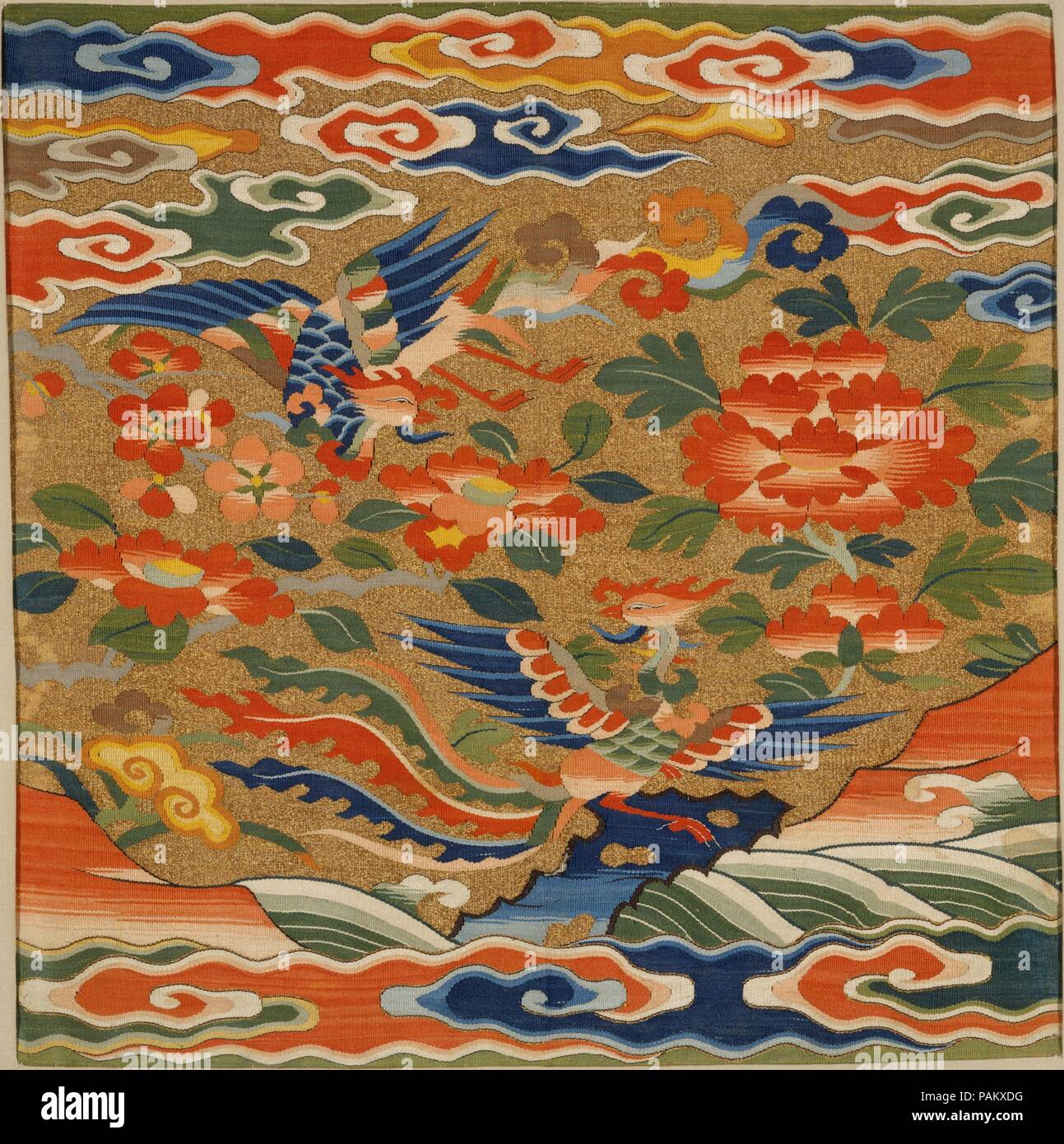 Rank Badge with Phoenixes. Culture: China. Dimensions: Overall: 13 3/4 x 13 3/4 in. (34.9 x 34.9 cm) Mount: 17 1/2 x 18 in. (44.5 x 45.7 cm). Date: 16th century. The phoenixes appear in a symbolic landscape of clouds, waves, and a decorative rock surrounded by colorful flora: (clockwise from lower left) auspicious fungus, camellia, prunus, and (dominating the right) tree peonies. Unpatterned edges at the top and bottom of the textile (now hidden under the mat) suggest it was woven for a special purpose, probably as a decorative rank insignia for a female member of the imperial household. Mus Stock Photohttps://www.alamy.com/image-license-details/?v=1https://www.alamy.com/rank-badge-with-phoenixes-culture-china-dimensions-overall-13-34-x-13-34-in-349-x-349-cm-mount-17-12-x-18-in-445-x-457-cm-date-16th-century-the-phoenixes-appear-in-a-symbolic-landscape-of-clouds-waves-and-a-decorative-rock-surrounded-by-colorful-flora-clockwise-from-lower-left-auspicious-fungus-camellia-prunus-and-dominating-the-right-tree-peonies-unpatterned-edges-at-the-top-and-bottom-of-the-textile-now-hidden-under-the-mat-suggest-it-was-woven-for-a-special-purpose-probably-as-a-decorative-rank-insignia-for-a-female-member-of-the-imperial-household-mus-image213108828.html
Rank Badge with Phoenixes. Culture: China. Dimensions: Overall: 13 3/4 x 13 3/4 in. (34.9 x 34.9 cm) Mount: 17 1/2 x 18 in. (44.5 x 45.7 cm). Date: 16th century. The phoenixes appear in a symbolic landscape of clouds, waves, and a decorative rock surrounded by colorful flora: (clockwise from lower left) auspicious fungus, camellia, prunus, and (dominating the right) tree peonies. Unpatterned edges at the top and bottom of the textile (now hidden under the mat) suggest it was woven for a special purpose, probably as a decorative rank insignia for a female member of the imperial household. Mus Stock Photohttps://www.alamy.com/image-license-details/?v=1https://www.alamy.com/rank-badge-with-phoenixes-culture-china-dimensions-overall-13-34-x-13-34-in-349-x-349-cm-mount-17-12-x-18-in-445-x-457-cm-date-16th-century-the-phoenixes-appear-in-a-symbolic-landscape-of-clouds-waves-and-a-decorative-rock-surrounded-by-colorful-flora-clockwise-from-lower-left-auspicious-fungus-camellia-prunus-and-dominating-the-right-tree-peonies-unpatterned-edges-at-the-top-and-bottom-of-the-textile-now-hidden-under-the-mat-suggest-it-was-woven-for-a-special-purpose-probably-as-a-decorative-rank-insignia-for-a-female-member-of-the-imperial-household-mus-image213108828.htmlRMPAKXDG–Rank Badge with Phoenixes. Culture: China. Dimensions: Overall: 13 3/4 x 13 3/4 in. (34.9 x 34.9 cm) Mount: 17 1/2 x 18 in. (44.5 x 45.7 cm). Date: 16th century. The phoenixes appear in a symbolic landscape of clouds, waves, and a decorative rock surrounded by colorful flora: (clockwise from lower left) auspicious fungus, camellia, prunus, and (dominating the right) tree peonies. Unpatterned edges at the top and bottom of the textile (now hidden under the mat) suggest it was woven for a special purpose, probably as a decorative rank insignia for a female member of the imperial household. Mus